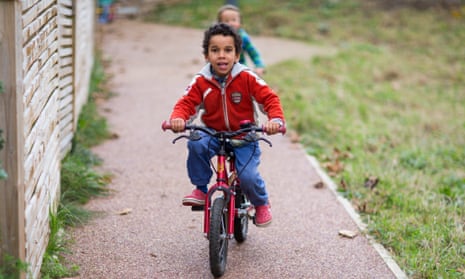Which are the best cities for children to live in? It’s a trick question in some ways because children do not get to choose. Adults make them live there – adults who may or may not know what is really “best” for children.
So how do we judge? Do we trust the evaluation of children themselves? Mine would want not want to live in a city. They would want to live in a padded cell with Wi-Fi, an iPad and a lifetime’s supply of Oreos. Do we instead trust the assessment of parents and “experts” who tell us what’s best for children? Or is there a top 10 that will tell us where to live?
Of course there is. In the UK, Norwich (“urban pleasures but not too hectic”), Cheltenham (“bustling town centre”) and Great Missenden (“Roald Dahl museum”) regularly top these kinds of surveys, which often seem to be based on estate-agent-speak rather than real lives. Every year Forbes magazine compiles a list of the best US cities to raise a family.
This year Grand Rapid, Michigan was number one, praised for its school system, edging out Boise, Idaho – “lower cost and less crime” than bigger Pacific Northwest cities Seattle and Portland – at number two and Provo, Utah (“no major metro has a lower crime rate”) at number three.
While no one wants to raise a family in a high-crime area or somewhere without schools, these evaluations do seem strangely unimaginative. They are based on things that affect children but that they never have to know about (we hope): house affordability, crime-rate ranking, local school quality. Or they’re based on behaviours that most people never exhibit: “Oh, I know, I’ll look up where the lowest crime rate is and we’ll move there.”
Or one-off features that won’t enhance everyday life. (Really, how often are you going to go to the Roald Dahl museum?) Cleverly, though, they also see average parental commuting delays as a positive for child-friendliness. Because the fewer delays, the more you see your parents. But that’s also subjective. There might be some kids who really wish their parents’ commute was more frequently delayed.
These are all things that (sensible) parents care about. They’re also totally obvious (and therefore a bit unhelpful). Equally no-brainer are the family-friendly destinations frequently cited by TripAdvisor: Florence, Edinburgh, London, Berlin, Barcelona. All very well for a week, but what about living there? What are the less obvious things that make a city fun and liveable for children and teenagers – not to visit, but to live in?

Increasingly, town-planning types base their rating of a city as “child-friendly” on something called “the popsicle test”. The popsicle test will be familiar to anyone who grew up in the 1970s, whose neighbourhood probably unknowingly passed it with flying colours. The test is this: a child can safely walk to a store, buy a popsicle and return home before it melts. (The real test, of course, is whether you can find a popsicle for under £1. Or a proper popsicle generally.) Tim Gill is one of the UK’s leading thinkers on childhood and author of No Fear: Growing Up in a Risk-Averse Society. He is a fan: “It’s a good test, precisely because it focuses on a central idea in child-friendliness: children’s everyday freedoms and choices. And it links this directly to local geography and perceived safety.”
There’s still a preconception that cities are not the healthiest place to raise children, though. With the rise of so-called “micro-apartments” in city centres, Aaron M Renn, the influential urban analyst behind the blog The Urbanophile, argued last year that in the US, cities “have become unbalanced in favour of singles”. Families only stay if they can’t afford to leave, he says. About inner-city living for families in the US, he says: “The fact that so many children in the city are in fact those whose parents are too poor to get out and who need extensive public support just to survive is not something to be celebrated.” But this trend has also given rise to a movement of urbanist blogs, such as The Urbanist and Jillian Glover’s This City Life, dedicated to “celebrating life in compact spaces” and “embracing life in a smaller home”. (Don’t you love euphemism?) Part of the urbanist project is about reclaiming this space, so that families don’t feel forced to move out.
Gill points to the renewed focus in friendly-city thinking on green spaces and outdoor play, in the UK and abroad. In London there is a campaign to see the citynamed the world’s first national park city, to promote conservation issues and protect London’s outdoor space. London has 3,000 parks and its garden space covers 24% of the capital. In other cities, communities are re-adapting their existing space to turn back the clock: Bristol-based Playing Out is a national advice service that helps people close off their streets so that children can play. It was founded in 2009 and as of 2014 50 Bristol streets had applied to the council for temporary play street orders, allowing residents to close their streets to traffic for up to three hours a week.

Eric Feldman lives in Washington DC and is an urban designer with award-winning architectural firm Rhodeside & Harwell. He writes a blog for Plan.Place about how his professional thinking is being changed by navigating the city with “a 34-inch sub-consultant” in the shape of his two-year-old daughter. He is also on board with the popsicle test. “The main value is how it illustrates, quite simply and clearly, an underlying truth in city planning: if a neighbourhood works for the youngest (and oldest) members of the community, then chances are it will work well for everyone. Will corner stores and popsicles alone enable us to crack the code of child-friendly cities? No. However, the presence of corner stores does signify a certain measure of walkability and reduced reliance on cars. And I do think that walkability – and, more specifically, the presence of a range of destinations close to home and accessible on foot (or bicycle) – is a key element of child-friendly cities.”
His interest lies in what planners called “the toddler walkshed”, a variety of safe experiences and amenities within the walking tolerance of a toddler. Obviously he has his personal reasons for this: “My daughter is drawn to the minutiae of the city, the micro-landmarks. Whether it’s shouting into storm drains or hugging street trees.” But there’s a broader lesson: if a city is friendly to a toddler, it is friendly to human beings generally. “My daughter is able to have a diverse range of experiences – kiddie concerts, story hours, sampling produce at the farmer’s market, swimming classes, the playground, art, pockets of nature – all within a meandering 20-minute stroll at toddler speed. While this might be just a weekend luxury for us, it is also actually quite important during the week for my daughter’s care provider.”
What about children themselves, though, especially those old enough to voice an opinion about where they want to live? Aren’t they better off in a “safe” neighbourhood in the suburbs? “Children want some similar things to adults – including having fun, spending time with their friends and having some choice and freedom in their daily lives. But parental priorities and choices can work against this,” says Gill. “For instance, many parents are attracted to suburban life, perhaps because it seems close to the ideal of the ‘rural idyll’. But for children this can mean they live in a goldfish bowl. Everything is far away, and they are dependent on the parental taxi service to get around.”
Gill is pleased with the experience his 17-year-old daughter has had of growing up in Walthamstow. “It can be scruffy and edgy at times, and I’m not sure I’d have been so relaxed about the area if she’d been a boy.” He explains that navigating urban territories can be tough for them. “But throughout her childhood she’s had easy access to culture, green and natural spaces like the Lea Valley Park and Epping Forest, good schools – that’s important for children as well as parents – convenient and cheap (for her) public transport, and a mixed yet neighbourly community, with lots of friends within walking distance. That’s a mix you only get in cities. As a result, she’s now pretty streetwise and confident in her identity as a Londoner.”
The best city to live in? Gill goes for Freiburg, Germany. “Compact, green, very walkable and cycleable, designed around people, not cars,” he says. Feldman opts for home: “Though it’s certainly not perfect – and, frankly, no city is – I find Washington DC to be a remarkably and uniquely child-friendly city,” he says. “Of course there are long-term challenges to living here – the cost and availability of suitable housing; school uncertainties – which our family is trying to navigate now. But in the last few days alone, my daughter and I visited free museums, took a merry-go-round ride on the National Mall, dangled our feet in a large sculpture garden fountain while watching ducklings swim nearby, brought books home from our neighbourhood library, browsed the farmer’s market, visited the park two blocks away on numerous occasions (on foot and tricycle) — all without having to travel very far.
“And as it turns out, my daughter recently tried her first-ever popsicle, from a street vendor near the museum.” Not a 100% test pass in the popsicle test, but pretty damn close.
Follow Guardian Cities on Twitter and Facebook and join the discussion

Comments (…)
Sign in or create your Guardian account to join the discussion